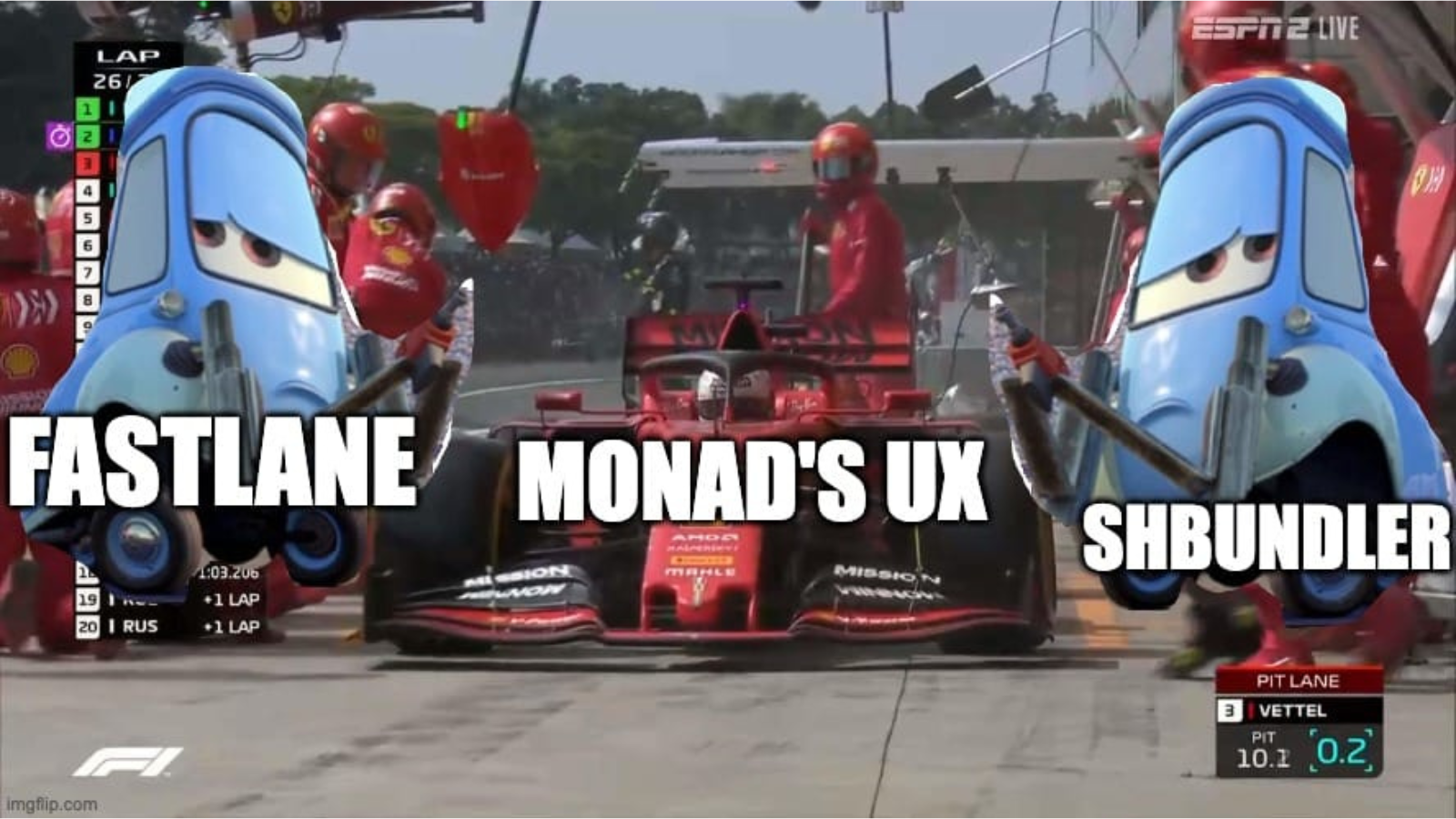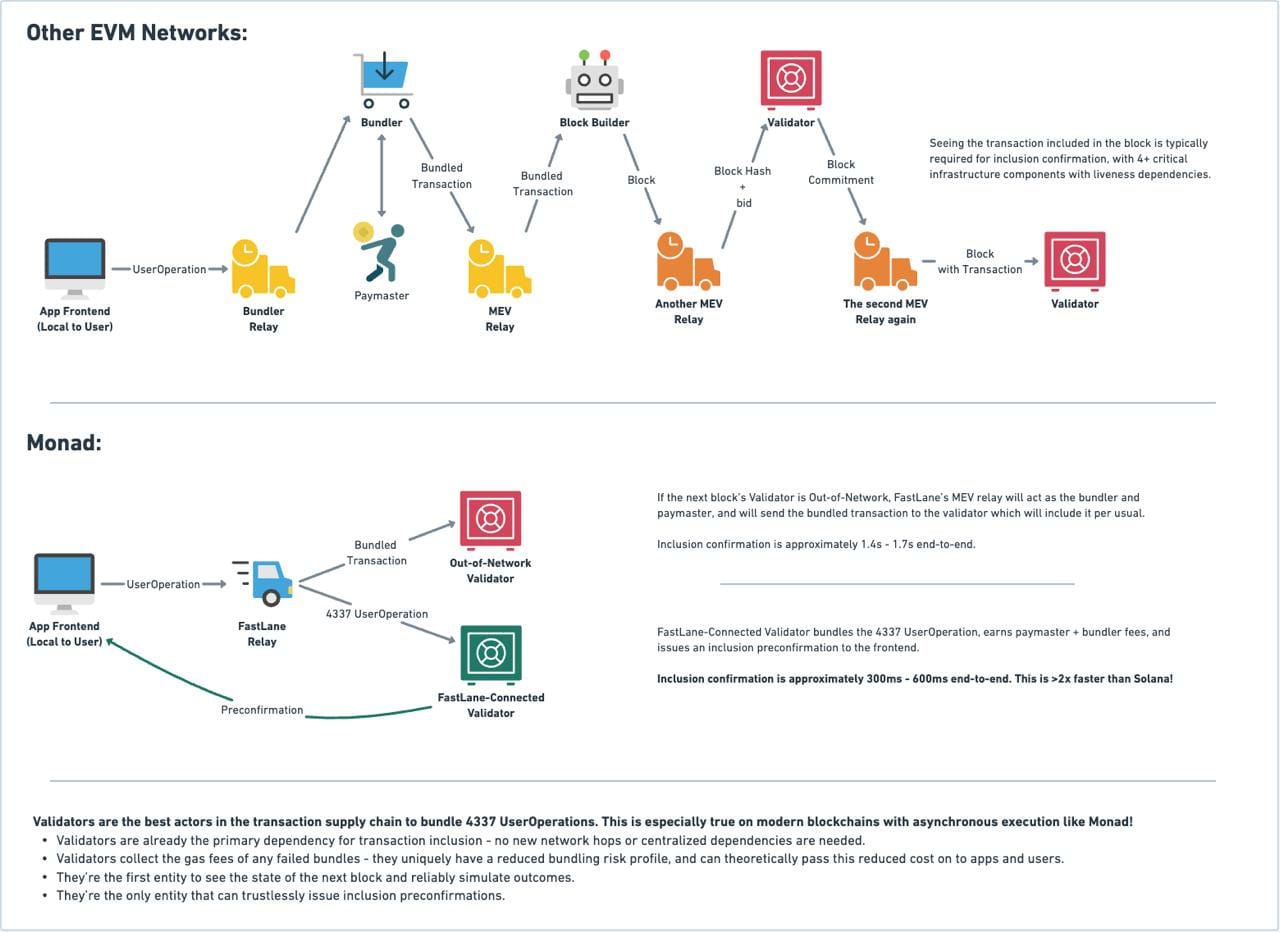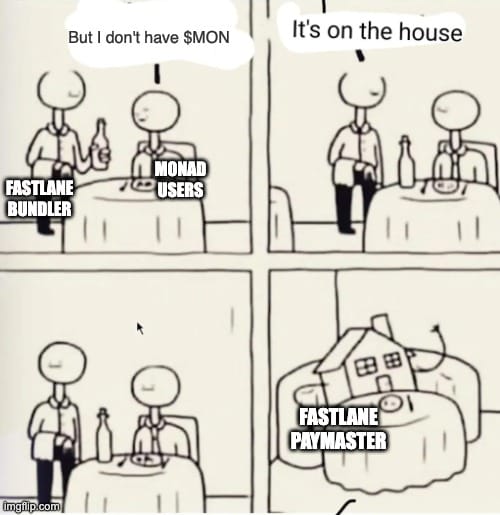The FastLane shBundler: Supercharging Monad’s UX for Users and Businesses.
2025-02-07

Introduction
The cryptocurrency world has evolved significantly over the past decade, with growing recognition, adoption, and utilisation by institutions, businesses, and end-users alike. As the gap between the crypto world and the real world closes, the demand for highly scalable, cost-effective, and robust blockchains has surged. Monad is set to meet this demand with a next-generation architecture, allowing them to serve the incoming masses at a global scale.
As a team with years’ worth of experience and a stellar track record in driving innovation and security in blockchain-based ecosystems, our entry into the Monad project and ecosystem has been guided by our passion for Monad’s mission and our desire to contribute by answering a key question: How can we make the Monad experience even better, faster, and more robust for users and businesses?
After years of research, engineering, and testing, we at FastLane have developed a number of solutions to further enhance the already promising experience on Monad. Quite frankly, we’ve been excited to unveil these innovations to the public for a long time.
In this article, we take the first step in revealing one of our many solutions launching exclusively on Monad: The FastLane shBundler.

Spearheading Monad’s Account Abstraction Layer
Today, the greatest challenge to mass blockchain adoption is User Experience (UX). Despite numerous breakthroughs and innovations that offer low-latency and low-cost transactions, many blockchain projects still fall short due to poor high-level abstractions and UX provisions for businesses, institutions, and general consumers.
To give Monad and its users a competitive edge with top-tier UX and to sidestep this common pitfall, we turned to a solution widely recognised for enabling exceptional user experiences in other ecosystems: ERC-4337, the account abstraction standard.
ERC-4337 introduces intuitive UX features once considered impossible in blockchain systems, including feeless (gasless) transactions, SSO-based logins, and account recovery. Recognizing this potential, we built the FastLane shBundler—a highly robust, modular, and domain-specific ERC-4337-compliant bundler—as the core infrastructure supporting Monad’s account abstraction layer.
The FastLane shBundler introduces a number innovations and new functionalities, including:
- Validator-based Bundling
- A Robust Escrow system for Deferred Execution
- Fee abstraction for costless access to Monad at mainnet launch—even without native currency.
Let’s briefly explore these innovations:
Validator-based Bundling
Most ERC-4337-compliant bundler implementations operate without the consensus validator or block-producing node being aware of the bundler’s processes, such as UserOp submissions and solving. As a result, these bundlers rely on unnecessary middleware and intermediaries to coordinate and deliver their final bundled transactions, introducing significant latency and inefficiencies that degrade execution quality for users and the broader ecosystem.
Recognizing these inefficiencies and leveraging our understanding (and assumptions) of Monad’s architecture, we arrived at what we call Validator-based Bundling—an approach to streamlining the entire account abstraction supply chain and execution process.
Validator-based bundling is a bundler scheme that eliminates inefficient steps and unnecessary intermediaries by vertically integrating the bundler infrastructure directly into the native stack of a Monad consensus validator. This design is accessible by running the FastLane node software, enabling a Monad consensus validator to function as a bundler—and even as a paymaster, if they prefer—for the account abstraction layer, unlocking new revenue opportunities for validator operators and their stake delegators.

To facilitate this bundling scheme, we introduced the FastLane Relay Network—an overlay network to facilitate the reception and relaying of UserOps.
- Serve as a relay for UserOps to a FastLane-powered consensus validator for bundling and execution—if the validator is the next scheduled block producer.
- Serve as a bundler—and optionally as a paymaster—itself—if the next scheduled block producer is not a FastLane-powered validator.
Additionally, a neat feature unlock we envision from Validator-based bundling is inclusion preconfirmations. In the ideal scenario—where a FastLane-powered consensus validator processes a UserOp—users could receive sub-second feedback responses for their transaction submissions. This significantly improves the user experience, complementing what Monad’s core design offers by default.
Essentially, validator-based bundling in account abstraction provides users with a superior user experience by maximizing the potential of Monad consensus validators running FastLane's software.
Robust Escrows for Deferred Execution
Monad’s Deferred Execution (a.k.a. Asynchronous Execution) optimizes transaction throughput and maximizes bandwidth efficiency by decoupling consensus from execution. Instead of executing transactions immediately after validation, Deferred Execution delays execution until a predefined future block—reducing overhead seen in earlier blockchain systems.
For core system performance objectives, this provides a significant advantage in achieving peak efficiency gains. However, for business and end-user applications, it introduces a new risk—particularly for paymasters: an attack vector we’ve identified and termed Delayed Solvency Attacks.
A Delayed Solvency Attack occurs when the bundler’s simulation doesn’t match the reality at the time of execution. Because of asynchronous execution, the bundler’s simulation will be at least 1 block behind the “true” current state of the network. So when the actual execution happens, the state may have changed. For example, a malicious user or paymaster may move their funds in between the simulation and execution of the transaction, causing the execution to revert and the bundler having to pay the gas costs. (Colloquially, this could be considered “rug-pulling” the paymaster.)
Imagine you’re a handyman hired to remodel a bathroom. Your client lacks cash on hand but writes you a check and even shows proof of a healthy bank balance. Reassured, you purchase materials and complete the job. But when you try to cash the check, the bank tells you the funds are gone—the client withdrew everything. You’ve now lost time, money, and effort. Similarly, paymasters in a Delayed Solvency Attack front transaction costs only to find that the expected reimbursement has vanished before it can be claimed.

Delayed Solvency Attacks emerge due to Deferred Execution in Monad, where transactions are ordered in real-time but executed with a delay—specifically, two blocks after the block in which they are included. This creates a two-block execution lag, posing challenges for actors and observers, such as paymasters, as simulations cannot reliably predict the system’s final state post-execution.
While building shBundler, we realized this would pose a significant problem—not just for us, but for the entire Monad ecosystem. So, we set out to develop a solution—because when life gives you lemons, you make lemonade, and lucky for us, we’re in the lemonade-making business.
Our solution? A robust escrow system, powered by a super holistic resource mechanism natively integrated into our shBundler deployment, leveraging Monad’s core security to ensure that funds designated for reimbursing the paymaster remain securely reserved in the system until after block execution—when the paymaster can successfully claim them. All of this happens seamlessly, without degrading user experience or execution efficiency for any party involved.
Our escrow system for shBundler ensures that users, businesses, and—most importantly—key infrastructure providers for account abstraction, such as paymasters, can engage safely while benefiting from the top-notch UX that shBundler offers, just as they would on any other system before Monad.
FastLane Paymaster: Delivering Feeless Transactions on Monad from Day 1
Good builders ship good tech. Great builders ship tech that simplifies the lives of everyday users. The advancements and discoveries made during the development of shBundler have been an invaluable learning experience, deepening our understanding of key aspects of Monad. But ultimately, the thoughtful design choices behind shBundler serve a greater purpose: enabling FastLane’s global community to access and use Monad from Day 1—even without holding its native currency.

This brings us to the cherry on top of shBundler—our very own FastLane Paymaster, designed to abstract and streamline the fee system for users while delivering the intuitive experience we believe should be the standard in the cryptocurrency space. We’re actively integrating with top DEXs, wallets, and other key apps and infrastructure providers to extend this fee-abstracted experience across the entire Monad ecosystem.
With the FastLane Paymaster, we’re working towards enabling:
- General users and businesses to pay for their onchain transactions using custom tokens such as USDC, PENGU, Fartcoin, and more.
- Established Paymasters from other ****ecosystems to seamlessly extend their support to Monad, ensuring they can deliver their services with the same consistency as in the ecosystems they already operate in.
For many users and businesses, the FastLane Paymaster will be a critical piece of our 4337-based account abstraction layer, delivering some of the most transformative UX improvements in any blockchain ecosystem.
Building the Future of Account Abstraction on Monad, Together.
With the launch of shBundler—featuring validator-based bundling, a robust escrow system, and seamless fee abstraction—FastLane is shaping and advancing the account abstraction landscape on Monad. This is just the beginning, and we’re excited to push the boundaries of what’s possible.
One more thing—as firm believers in building in public and open-source collaboration, we’re thrilled to announce that shBundler is now officially open to all. You can find our repository here: FastLane shBundler GitHub Repo. We invite developers, businesses, and community contributors to explore, integrate, and innovate with shBundler, and we can’t wait to see what you build.